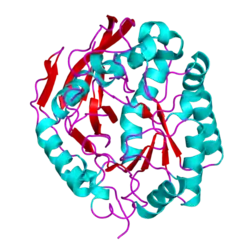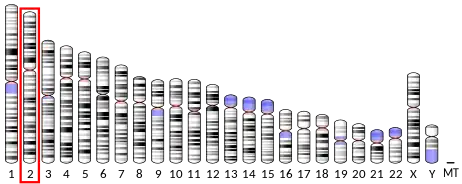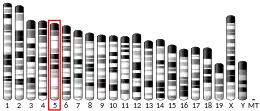CAD protein (carbamoyl-phosphate synthetase 2, aspartate transcarbamylase, and dihydroorotase) is a trifunctional multi-domain enzyme involved in the first three steps of pyrimidine biosynthesis. De-novo synthesis starts with cytosolic carbamoylphosphate synthetase II which uses glutamine, carbon dioxide and ATP. This enzyme is inhibited by uridine triphosphate (feedback inhibition).
In 2015, the first observed pathological mutations of CAD were found in a four-year-old boy.[5]
CAD protein has been observed in the mid-piece of mammalian spermatozoa, among the mitochondria.[6]
Structure
CAD protein has a molecular weight of 243 KDa. It is a polypeptide made up of four different domains which make for a multi enzyme unit: Glutaminase (GLN), carbamoyl phosphate synthetase (CPS II), Dihydroorotase (DHO) and aspartate transcarbamoylase (ATC). The protein assembles into ~1.5MDa hexamers. More specifically, the DHO domain assembles into dimers, and ATC domains do so into trimers. The hexamers are then formed by DHO dimerization of two ATC trimers, and this connection does not impact the kinetic properties. In addition, it is thought that three GLN-CPS II dimers border the DHO-ATC complex. This is suggested by the fact that CPS II is not stable unless a part of the complex.[7] DHO and ATC and are thought to be the main part of the formation of the protein. The active site is covered by a carboxylated lysine, serving as a bridge for two zinc ions (+2 charge). Another zinc ion helps stabilize a histidinate ion. The zinc and lysine are involved in the activity of the enzyme.[8]
Function
This protein starts and controls the creation of pyrimidines in animals by acting as an enzyme. CAD is known to perform multiple reactions. For example, GLN and CPS II create carbamoyl phosphate from bicarbonate, glutamine, and two ATP molecules. The ATC then takes the newly made carbamoyl phosphate and forms carbamoyl aspartate by reacting with aspartate. DHO then takes carbamoyl aspartate and converts it to dihydroorotate. This molecule is a precursor of a pyrimidine ring, and this process shows the CAD protein's function in pyrimidine synthesis through carbamoyl-phosphate synthase and dihydroorotase activity.[7]
In order to function, CAD requires certain co-factors. Zinc (+2) is needed for dihydroorotase activity, and thus three Zn+2 molecules bind to each subunit. Magnesium and manganese are also necessary, and either element is bound with four per subunit.[8] The Michaelis-Menten constant, Km, shows the affinity of two molecules for one another. The Km of CAD for dihydroorotate is 28μM, and for N-carbamoyl-L-aspartate, it is 241μM.[9]
Regulation
CAD protein is regulated by various molecules in order to increase or stop enzymatic activity. Uridine-5′-triphosphate (UTP) is an end product that allosterically inhibits the CPS II step through negative feedback. Additionally, UMP acts as an allosteric inhibitor to the CPS II reaction. On the other hand, this step is activated by 5-phosphoribosyl-α-pyrophosphate (PRPP), which is also a reactant for purine and pyrimidine synthesis. CAD activity is stimulated by the S6 kinase-dependent phosphorylation of CAD at the S1859 site downstream of mTORC1 signaling.[10][11] CAD is also regulated by mLST8, an mTORC1/2 component.[12]
Medical Implications
Congenital disorder of glycosylation, Type Iz is a rare disease caused by mutations in the CAD gene. This disease causes epileptic encephalopathy, normocytic anemia, anisopoikilocytosis, and a delay in childhood development. The disease is hereditary and autosomal recessive, and can be fatal in the early years of life.[13]
There is also potential use for CAD protein as a target for treating certain tumors, as its role in pyrimidine synthesis can be manipulated to destroy cancer cells that are always growing and in need of new nucleotides. CAD can also be enhanced in order to increase certain types of cancer cells to chemotherapy. This has been shown to be specifically helpful in the treatment of Triple Negative Breast Cancer (TNBC) in vitro and in vivo.[14]
References
- 1 2 3 GRCh38: Ensembl release 89: ENSG00000084774 - Ensembl, May 2017
- 1 2 3 GRCm38: Ensembl release 89: ENSMUSG00000013629 - Ensembl, May 2017
- ↑ "Human PubMed Reference:". National Center for Biotechnology Information, U.S. National Library of Medicine.
- ↑ "Mouse PubMed Reference:". National Center for Biotechnology Information, U.S. National Library of Medicine.
- ↑ Ng BG, Wolfe LA, Ichikawa M, Markello T, He M, Tifft CJ, et al. (June 2015). "Biallelic mutations in CAD, impair de novo pyrimidine biosynthesis and decrease glycosylation precursors". Human Molecular Genetics. 24 (11): 3050–7. doi:10.1093/hmg/ddv057. PMC 4424951. PMID 25678555.
- ↑ Carrey EA, Dietz C, Glubb DM, Löffler M, Lucocq JM, Watson PF (June 2002). "Detection and location of the enzymes of de novo pyrimidine biosynthesis in mammalian spermatozoa". Reproduction. 123 (6): 757–68. doi:10.1530/rep.0.1230757. PMID 12052230.
- 1 2 Moreno-Morcillo M, Grande-García A, Ruiz-Ramos A, Del Caño-Ochoa F, Boskovic J, Ramón-Maiques S (June 2017). "Structural Insight into the Core of CAD, the Multifunctional Protein Leading De Novo Pyrimidine Biosynthesis". Structure. 25 (6): 912–923.e5. doi:10.1016/j.str.2017.04.012. hdl:10261/166586. PMID 28552578.
- 1 2 Del Caño-Ochoa F, Grande-García A, Reverte-López M, D'Abramo M, Ramón-Maiques S (December 2018). "Characterization of the catalytic flexible loop in the dihydroorotase domain of the human multi-enzymatic protein CAD". The Journal of Biological Chemistry. 293 (49): 18903–18913. doi:10.1074/jbc.RA118.005494. PMC 6295737. PMID 30315107.
- ↑ "CAD Gene - GeneCards | PYR1 Protein | PYR1 Antibody". genecards.weizmann.ac.il. Retrieved 2020-04-27.
- ↑ Ben-Sahra, I; Howell, JJ; Asara, JM; Manning, BD (15 March 2013). "Stimulation of de novo pyrimidine synthesis by growth signaling through mTOR and S6K1". Science. 339 (6125): 1323–8. Bibcode:2013Sci...339.1323B. doi:10.1126/science.1228792. PMC 3753690. PMID 23429703.
- ↑ Robitaille, AM; Christen, S; Shimobayashi, M; Cornu, M; Fava, LL; Moes, S; Prescianotto-Baschong, C; Sauer, U; Jenoe, P; Hall, MN (15 March 2013). "Quantitative phosphoproteomics reveal mTORC1 activates de novo pyrimidine synthesis". Science. 339 (6125): 1320–3. Bibcode:2013Sci...339.1320R. doi:10.1126/science.1228771. PMID 23429704. S2CID 206544538.
- ↑ Nakashima, A; Kawanishi, I; Eguchi, S; Yu, EH; Eguchi, S; Oshiro, N; Yoshino, K; Kikkawa, U; Yonezawa, K (18 April 2013). "Association of CAD, a multifunctional protein involved in pyrimidine synthesis, with mLST8, a component of the mTOR complexes". Journal of Biomedical Science. 20 (1): 24. doi:10.1186/1423-0127-20-24. PMC 3639846. PMID 23594158.
- ↑ "CAD-CDG | Genetic and Rare Diseases Information Center (GARD) – an NCATS Program". rarediseases.info.nih.gov. Retrieved 2020-04-26.
- ↑ Brown KK, Spinelli JB, Asara JM, Toker A (April 2017). "De Novo Pyrimidine Synthesis Is a Metabolic Vulnerability in Triple-Negative Breast Cancer". Cancer Discovery. 7 (4): 391–399. doi:10.1158/2159-8290.CD-16-0611. PMC 5380483. PMID 28255083.
External links
- CAD+trifunctional+enzyme at the U.S. National Library of Medicine Medical Subject Headings (MeSH)
- Human CAD genome location and CAD gene details page in the UCSC Genome Browser.
- Overview of all the structural information available in the PDB for UniProt: P27708 (CAD protein) at the PDBe-KB.




